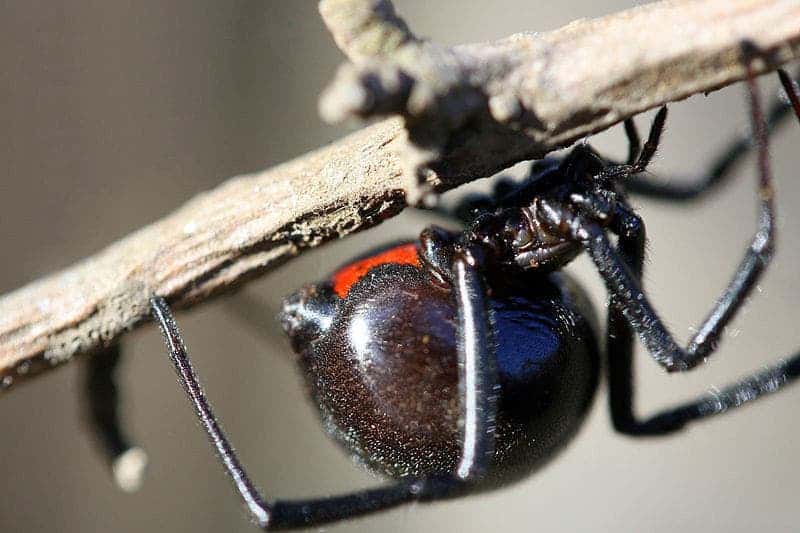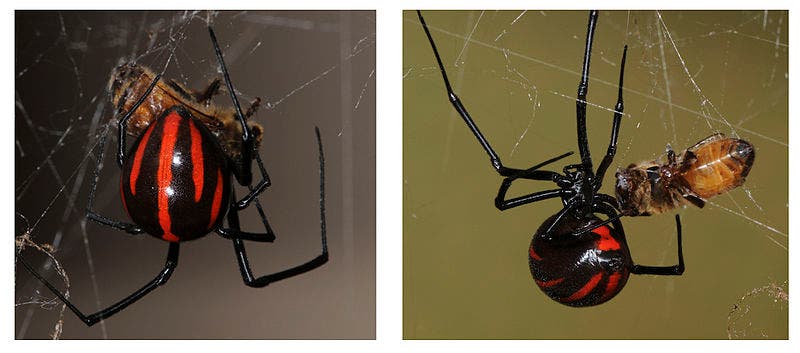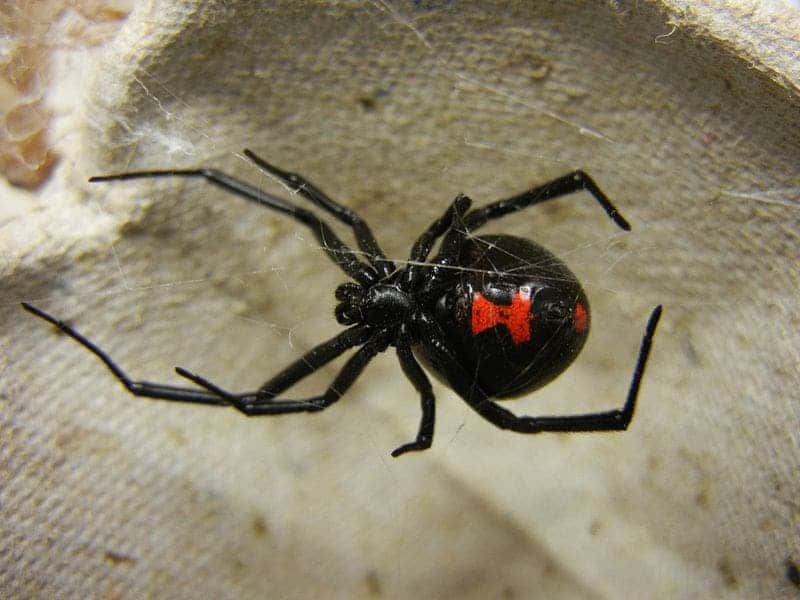
Black widows are perhaps the most famous spiders in the world. But as is often the case with celebrities, myths, and rumors outweigh actual facts in the public consciousness. Let’s have a look.
Black widow venom is very strong, but their bite isn’t actually THAT dangerous
Did you know a black widow’s venom is about 15 times stronger than a rattlesnake’s? Yikes!
However, they’re also more than 1,000 times smaller and, what’s more, the black widow doesn’t release all of its venom at once. Remember, the dose makes the poison.
When a black widow bites a human, neurotoxins in the venom can cause pain, swelling around the wound, cramping, sweating, and chills.
These are some pretty nasty symptoms, but they’re not nearly as concerning as some think. The black widow’s venom is meant to neutralize tiny prey like insects, not kill large predators like humans.
Every year, thousands of people get bitten by a black widow in the United States, mostly in the south and western regions of the country where the spiders thrive. Less than 1% of these cases resulted in severe symptoms. When severe symptoms occur, most hospitals now have antivenom which neutralizes the neurotoxins.
Black widows are not the most dangerous spiders in the world
Black widows are sometimes called the deadliest spiders in the world — but that’s not true at all. Although fatalities may happen — usually to small children, the elderly, or the infirm — these are extremely uncommon.
Many years can go by without any black widow-related fatalities. The world’s deadliest spider is actually the male Sydney funnel-web spider, Atrax robustus, which (of course) can be found in Australia.
Black widows almost never bite people unprovoked. The spiders will bite in self-defense when they feel threatened, usually when a person accidentally steps or sits on them.
Black widows like to hunt in vineyards, outdoor toilets, and other shelters where debris builds up, so it’s best to be extra careful in these contexts. According to one 2014 study, people are most at risk of getting bitten by a black widow when it is squeezed or pinched.
Females have a reputation as man-eaters, but that’s a myth
In popular culture, women who kill their husbands are sometimes called ‘black widows’, in reference to the notion that such female spiders devour the males after mating. However, this is a myth (with just a sliver of truth).
Research has shown that female redback spiders, which are closely related to black widows, eat their mates after copulation only about 2% of the time.
The notion that female black widows eat their mates can be traced to lab experiments in which a single male and a single female were trapped in the same enclosure.
Female black widows are up to 150 times larger than males, and thus can be much hungrier too. With nowhere to run, the males are at a huge risk of getting cannibalized. But in the wild, males have ample opportunities to escape.
To understand the facts about black widow mating, you must first understand that there are many different species worldwide in the black-widow group (genus Latrodectus), and three different black widow species in the United States alone, two in the east and one in the west (not counting the brown and red widows). These species do not all behave alike. Moreover, in the past, most observations of mating took place in laboratory cages, where males could not escape,” biologists affiliated with the Burke Museum wrote in a blog post.
“The only known Latrodectus species in which mate cannibalism in nature is the rule, not the exception, are in the Southern Hemisphere. Of U.S. species, mate cannibalism occurs sometimes in Latrodectus mactans, the eastern (southern) black widow, but most males survive to mate another day. In the other two black species, including the western black widow L. hesperus (only species west of Kansas), mate cannibalism has never been observed in the wild!” they added.
The black widow’s combed limbs give it ‘spidey senses’

Black widows spun their irregular, funnel-shaped webs using their combed hind pair of limbs. The tiny bristles covering the long limbs also allow the spiders to cover and trap their prey in silk once the unsuspecting victim is foolish enough to come close to the widow’s web.
Speaking of webs, the strands of silk also extend the widow’s senses. Once a fly slightly touches the web, vibrations are sent along the string, which can be sensed by organs on their leg joints.
Like their relatives, black widow spiders produce silks with exceptional material properties, including strength on par with steel.
In 2018, Northwestern University researchers found that the spiders employ a complex, hierarchical protein assembly process to produce their hyper-strong silk.
If the method can be mimicked, scientists believe we could make synthetic spider silk-like materials that could be used in high-performance textiles, cable bridges, and other constructions, replacements for plastic, and biomedical applications.
Only females have the emblematic red hourglass

While they’re juveniles, black widows are colored brown and white and only acquire their signature charcoal color once they molt and reach adulthood.
The adult females, but not the males, also develop a red hourglass mark on their abdomen, as well as a few red spots over the spinnerets (the silk-spinning organs of a spider) and along the middle of the back.
Scientists believe the red coloring helps the females, which are much larger than males and thus easier to spot, to ward off predators. In the animal kingdom, red marks send a clear ‘stay away, I’m dangerous’ message.
Black widows are getting replaced by brown windows in some places
The brown widow spider (Latrodectus geometricus Koch) resembles the black widow, however, the hourglass of the brown widow is yellowish-orange or reddish-orange instead of bright red as in the black widow.
They’re relatively new to North America, with the first documented sighting of a brown widow spider occurring in 1935, in Florida.
In the last decade, researchers have found that the range of the brown widow spider has been rapidly expanding, especially in California. They’ve become so successful they’ve started displacing native black widow spiders.
Males do not bite, however, the female brown widow is venomous and injects a neurotoxic venom when it bites that is nearly twice as potent as the black widow’s. However, the quantity of injected venom is very small so a brown widow’s bite is much less severe than a black widow’s.
Edits on 13 May 2023. Removed section that mentioned a source that has now been discredited.


